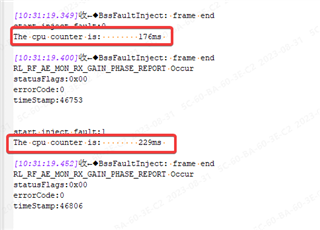Screenshot from the document 《AWR294x Safety Manual Functional v0.601》, as shown below:

It can be seen from the above figure that the test time is about 1ms.
In fact, when I configure the wave period to be 40ms (framePeriodicity=(40000000U / 5)), I inject a RX0 fault of RX_GAIN_DROP as shown in the figure below, and through log printing, it is found that the actual consumption is about 53ms. (229ms-176ms=53ms)

《mmWave Radar Interface Control Document Revision 3.30》
[10:31:19.349]收←◆BssFaultInject: frame end
start inject fault:0
The cpu counter is: 176ms
[10:31:19.400]收←◆BssFaultInject: frame end
RL_RF_AE_MON_RX_GAIN_PHASE_REPORT Occur
statusFlags:0x00
errorCode:0
timeStamp:46753
start inject fault:1
The cpu counter is: 229ms
[10:31:19.452]收←◆BssFaultInject: frame end
RL_RF_AE_MON_RX_GAIN_PHASE_REPORT Occur
statusFlags:0x00
errorCode:0
timeStamp:46806
Why is there such a big difference between the measured time and the 《AWR294x Safety Manual Functional v0.601》 time in the document? How can I achieve such a small time as stated in the documentation (about 1ms)?




